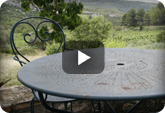 |
|
| |
| The Garraf Massif is a great mass of limestone which rises up between the Pre-Coastal mountain range, the Sierra of Ordal, the Garraf, Mediterranean and coastal plains. It is a series of high hills – some of them rising to an altitude of more than 500m – with gradients of between 30% and 50%, with narrow watercourses and gullies slicing deeply into the landscape. All of this means that the amount of arable land is limited. |
| The Garraf wine-growing region is a protected area within the traditional boundaries of the Garraf National Park. The Can Ràfols dels Caus estate is situated at an altitude of 300 m, and stands on a rise between the ravines of two watercourses surrounded by vineyards growing on the terraced slopes. From some of the highest vineyards, such as “la Calma” or “el Rocallís” the sea can be seen, some 15km away. This situation is paramount for obtaining healthy grapes, as they are sheltered from the damp air coming in from the coastline, but are equally protected from the sporadic hailstorms in the Sierra of Ordal or the Pre-Coastal mountain range. |
| The Garraf Massif has an unusual mesoclimate. The daytime is sun-drenched and hot despite the tempering effect of the sea, which sends in a cooling breeze towards the afternoon. This allows the vines to complete their growth cycle and reach full ripeness. Within a predominantly dry Mediterranean climate, the temperatures around the final period of ripening can average 24°C, with highs of 38°C and lows of 14°C, providing an extended period for ripening and allowing the sugar concentration and polyphenolic maturity to be reached gradually. Consequently, the more fragrant and subtle aromatic molecules can develop. Rainfall is scarce, with 350 litres per square metre during the growth period. |
Small bushes and intensely aromatic shrubs such as thyme, rosemary, pennyroyal mint and marjoram thrive in this area. It is not surprising, therefore, that traces of these herbal aromas can often be detected in the wines of Can Ràfols dels Caus.
A protected species which is endemic to the area is the dwarf palm (chamaerops humilis), and evergreen oaks and oak trees grow in the ravines and riverbank trees make a rare and shy appearance to reveal the unusual presence of a natural spring. Vineyards, olive groves and almond orchards occupy the small clearings between the pine woods. |
The soil is made up of Dolomitic limestone, which overlies strata of Dolomitic stone, white, blue and pink clay. The area is a watershed, carved by riverbed ravines, gullies, caves and potholes. The shallow topsoil is only about 40cm deep and contains up to 40% of quick lime, something which considerably limits productivity. Due to the marine origins of the area, fossils are not at all uncommon, and many can be found in the soil of the higher vineyards such as “la Calma” or “el Rocallís”.
Most of the soil on the estate is calcareous or “white” or is of the local and plentiful variety of clay which is peppered with lime nodules known as “cat’s brains”. The presence of such a high proportion of fossil matter provides a wealth of microelements and minerals that are absorbed by the plants, and lend a unique personality to the wines. In all great wines of notable character, there is a predominance of calcareous soil, which increases the wine’s potential to age well, holding its acidity and maintaining a clear profile.
|
| |
| Back to the Top |
| |
 |
| |
|
| |
|
| |
 |
| |
 |
|
 |
| Wine Tourism |
Cellar |
| Experience Can Ràfols |
In the heart of the Garraf |
|
 |
 |
| Our Wines |
Olive Oil |
| Nature's gift |
Exquisite golden olive oil |
| |
|
|
|
 |
|
 |
 |
| |
| |
|


























